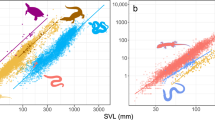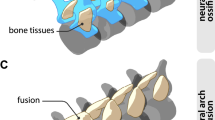Abstract
Endothermy and its evolution are still an unresolved issue. Here, we present a model which transforms an ectothermic amniote (ancestor) into a derived amniote (descendant) showing many characteristics seen in extant endothermic birds and mammals. Consistent with the fossil record within the ancestral lineages of birds and mammals, the model assumes that mutations in genes which get active during ontogeny and affect body growth resulted in a reduced asymptotic body size and an early growth stop of the descendant. We show that such a postulated early growth stop in the descendant simultaneously increases the growth rate and metabolic rate, and also changes six life history traits (offspring mass, annual clutch/litter mass, number of offspring per year, age and mass at which sexual maturity is reached, age at which the individual is fully grown) of the descendant compared to a similar-sized ancestor. All these changes coincide with known differences between recent ectothermic and endothermic amniotes. We also elaborate many other differences and similarities in biological characteristics supporting the early growth stop. An early stop in growth during ontogeny thus could have played a key role in the evolution of endothermy within the reptilia and therapsids. It generated variability in characteristics of ancestral ectotherms, which was subject to natural selection in the past and resulted in many adaptations linked to endothermy in today’s birds and mammals.



Similar content being viewed by others
References
Alberch P (1980) Ontogenesis and morphological diversification. Am Zool 20:653–667. https://doi.org/10.1093/icb/20.4.653
Alberch P, Gould SJ, Oster GF, Wake DB (1979) Size and shape in ontogeny and phylogeny. Paleobiology 5:296–317. https://doi.org/10.2307/2400262
Andrews RM, Pough FH (1985) Metabolism of squamate reptiles: allometric and ecological relationships. Physiol Zool 58:214–231
Bennett A, Ruben J (1979) Endothermy and activity in vertebrates. Science 206:649–654. https://doi.org/10.1126/science.493968
Bertalanffy LV (1957) Quantitative laws in metabolism and growth. Q Rev Biol 32:217–231
Bhullar B-AS, Marugan-Lobon J, Racimo F, Bever GS, Rowe TB, Norell MA, Abzhanov A (2012) Birds have paedomorphic dinosaur skulls. Nature 487:223–226
Bhullar B-AS et al. (2015) A molecular mechanism for the origin of a key evolutionary innovation, the bird beak and palate, Revealed by an integrative approach to major transitions in vertebrate history evolution. https://doi.org/10.1111/evo.12684
Blueweiss L, Fox H, Kudzma V, Nakashima D, Peters R, Sams S (1978) Relationships between body size and some life history parameters. Oecologia 37:257–272
Brown JH, Gillooly JF, Allen AP, Savage VM, West GB (2004) Toward a metabolic theory of ecology. Ecology 85:1771–1789
Case TJ (1978) On the evolution and adaptive significance of postnatal-growth rates in terrestrial vertebrates. Q Rev Biol 53:243–282
Clarke A, Pörtner H-O (2010) Temperature, metabolic power and the evolution of endothermy. Biol Rev 85:703–727. https://doi.org/10.1111/j.1469-185X.2010.00122.x
Cowles RB (1940) Additional implications of reptilian sensitivity to high temperatures. Am Nat 74:542–561. https://doi.org/10.2307/2457334
Dol'nik VR (2000) Allometry of reproduction in poikilotherm and homoiotherm vertebrates. Biol Bull 27:702–712
Ernest SKM et al (2003) Thermodynamic and metabolic effects on the scaling of production and population energy use. Ecol Lett 6:990–995
Farmer CG (2000) Parental care: the key to understanding endothermy and other convergent features in birds and mammals. Am Nat 155:326–334
Farmer CG (2003) Reproduction: the adaptive significance of endothermy. Am Nat 162:826–840
Fitzhugh HA (1976) Analysis of growth curves and strategies for altering their shape. J Anim Sci 42:1036–1051
Gaillard JM, Pontier D, Allaine D, Loison A, Herve JC, Heizmann A (1997) Variation in growth form and precocity at birth in eutherian mammals. Proc R Soc Lond B 264:859–868
Grady JM, Enquist BJ, Dettweiler-Robinson E, Wright NA, Smith FA (2014) Evidence for mesothermy in dinosaurs. Science 344:1268–1272. https://doi.org/10.1126/science.1253143
Gregory TR (2001) The bigger the C-value, the larger the cell: genome size and red blood cell size in vertebrates. Blood Cell Mol Dis 27:830–843. https://doi.org/10.1006/bcmd.2001.0457
Gregory TR (2002) A bird's-eye view of the c-value enigma: genome size, cell size, and metabolic rate in the class aves. Evolution 56:121–130. https://doi.org/10.1111/j.0014-3820.2002.tb00854.x
Grigg GC, Beard LA, Augee ML (2004) The evolution of endothermy and its diversity in mammals and birds. Physiol Biochem Zool 77:982–997. https://doi.org/10.1086/425188
Hulbert AJ (2000) Thyroid hormones and their effects: a new perspective. Biol Rev 75:519–631. https://doi.org/10.1111/j.1469-185X.2000.tb00054.x
Hulbert A (2014) A sceptics view: “Kleiber’s Law” or the “3/4 Rule” is neither a law nor a rule but rather an empirical approximation. Systems 2:186
Hulbert AJ, Else PL (1981) Comparison of the “mammal machine” and the “reptile machine”: energy use and thyroid activity AJP - regulatory. Integr Comp Physiol 241:R350–R356
Hulbert A, Else P (1990) The cellular basis of endothermic metabolism: a role for “leaky” membranes? Physiology 5:25–28
Hulbert AJ, Else PL (1999) Membranes as possible pacemakers of metabolism. J Theor Biol 199:257–274
Hulbert AJ, Else PL (2005) Membranes and the setting of energy demand. J Exp Biol 208:1593–1599. https://doi.org/10.1242/jeb.01482
Kemp TS (1988) Haemothermia or Archosauria? The interrelationships of mammals, birds and crocodiles. Zool J Linnean Soc 92:67–104. https://doi.org/10.1111/j.1096-3642.1988.tb01527.x
Kemp TS (2006a) The origin and early radiation of the therapsid mammal-like reptiles: a palaeobiological hypothesis. J Evol Biol 19:1231–1247
Kemp TS (2006b) The origin of mammalian endothermy: a paradigm for the evolution of complex biological structure. Zool J Linnean Soc 147:473–488. https://doi.org/10.1111/j.1096-3642.2006.00226.x
Koteja P (2000) Energy assimilation, parental care and the evolution of endothermy. Proc R Soc Lond B 267:479–484. https://doi.org/10.1098/rspb.2000.1025
Koteja P (2004) The evolution of concepts on the evolution of endothermy in birds and mammals. Physiol Biochem Zool 77:1043–1050
Lee AH, Werning S (2008) Sexual maturity in growing dinosaurs does not fit reptilian growth models. PNAS 105:582–587
Little AG, Seebacher F (2014) The evolution of endothermy is explained by thyroid hormone-mediated responses to cold in early vertebrates. J Exp Biol 217:1642–1648. https://doi.org/10.1242/jeb.088880
Lovegrove BG (2012) The evolution of endothermy in Cenozoic mammals: a plesiomorphic-apomorphic continuum. Biol Rev 87:128–162. https://doi.org/10.1111/j.1469-185X.2011.00188.x
McClure PA, Randolph JC (1980) Relative allocation of energy to growth and development of homeothermy in the eastern wood rat (Neotoma Floridana) and hispid cotton rat (Sigmodon Hispidus). Ecol Monogr 50:199–219
McNab BK (1978) The evolution of endothermy in the phylogeny of mammals. Am Nat 112:1–21. https://doi.org/10.2307/2460134
McNab BK (2008) An analysis of the factors that influence the level and scaling of mammalian BMR. Comp Biochem Phys A 151:5–28
McNab BK (2009) Ecological factors affect the level and scaling of avian BMR. Comp Biochem Phys A 152:22–45
Müller GB (1989) Ancestral patterns in bird limb development: a new look at Hampé's experiment. J Evol Biol 2:31–47. https://doi.org/10.1046/j.1420-9101.1989.2010031.x
Müller GB, Alberch P (1990) Ontogeny of the limb skeleton in Alligator Mississippiensis: developmental invariance and change in the evolution of archosaur limbs. J Morphol 203:151–164. https://doi.org/10.1002/jmor.1052030204
Newman SA, Mezentseva NV, Badyaev AV (2013) Gene loss, thermogenesis, and the origin of birds. Ann N Y Acad Sci 1289:36–47. https://doi.org/10.1111/nyas.12090
Organ CL, Shedlock AM (2009) Palaeogenomics of pterosaurs and the evolution of small genome size in flying vertebrates. Biol Lett 5:47–50. https://doi.org/10.1098/rsbl.2008.0491
Organ CL, Shedlock AM, Meade A, Pagel M, Edwards SV (2007) Origin of avian genome size and structure in nonavian dinosaurs. Nature 446:180–184. https://doi.org/10.1038/nature05621
Pardo SA, Cooper AB, Dulvy NK (2013) Avoiding fishy growth curves. Methods Ecol Evol 4:353–360. https://doi.org/10.1111/2041-210x.12020
Pauly D (1980) On the interrelationships between natural mortality, growth parameters, and mean environmental temperature in 175 fish stocks. J Conseil 39:175–192. https://doi.org/10.1093/icesjms/39.2.175
Pörtner HO (2004) Climate variability and the energetic pathways of evolution: the origin of endothermy in mammals and birds. Physiol Biochem Zool 77:959–981. https://doi.org/10.1086/423742
Ricklefs RE (1979) Patterns of growth in birds. V. A comparative study of development in the Starling, common tern, and Japanese quail. Auk 96:10–30
Ricklefs RE (1987) Characterizing the development of homeothermy by rate of body cooling. Funct Ecol 1:151–157. https://doi.org/10.2307/2389719
Ricklefs RE (2010) Life-history connections to rates of aging in terrestrial vertebrates. Proc Natl Acad Sci U S A 107:10314–10319. https://doi.org/10.1073/pnas.1005862107
Ruben J (1995) The evolution of endothermy in mammals and birds: from physiology to fossils. Annu Rev Physiol 57:69–95
Sánchez-Villagra MR (2010) Developmental palaeontology in synapsids: the fossil record of ontogeny in mammals and their closest relatives. Proc R Soc Lond B. https://doi.org/10.1098/rspb.2009.2005
Schweitzer MH, Marshall CL (2001) A molecular model for the evolution of endothermy in the theropod-bird lineage. J Exp Zool 291:317–338
Seebacher F, Schwartz TS, Thompson MB (2006) Transition from ectothermy to endothermy: the development of metabolic capacity in a bird (Gallus gallus). 273(1586). https://doi.org/10.1098/rspb.2005.3333
Shine R (2005) Life-history evolution in reptiles. Annu Rev Ecol Evol Syst 36:23–46
Shine R, Charnov EL (1992) Patterns of survival, growth, and maturation in snakes and lizards. Am Nat 139:1257–1269
Shine R, Iverson JB (1995) Patterns of survival, growth and maturation in turtles. Oikos 72:343–348
Sieg AE, O'Connor MP, McNair JN, Grant BW, Agosta SJ, Dunham AE (2009) Mammalian metabolic allometry: do intraspecific variation, phylogeny, and regression models matter? Am Nat 174:720–733
Silva JE (2003) The thermogenic effect of thyroid hormone and its clinical implications. Ann Intern Med 139:205–213. https://doi.org/10.7326/0003-4819-139-3-200308050-00018
Silva JE (2006) Thermogenic mechanisms and their hormonal regulation. Physiol Rev 86:435–464. https://doi.org/10.1152/physrev.00009.2005
Starck JM, Ricklefs RE (eds) (1998) Avian growth and development, Evolution within the altricial-precocial spectrum. Oxford University Press, New York
Turner AH, Pol D, Clarke JA, Erickson GM, Norell MA (2007) A basal dromaeosaurid and size evolution preceding avian flight. Science 317:1378–1381
Visser GH, Ricklefs RE (1995) Relationship between body composition and homeothermy in neonates of precocial and semiprecocial birds. Auk 112:192–200
Werner J, Griebeler EM (2011) Reproductive biology and its impact on body size: comparative analysis of mammalian, avian and dinosaurian reproduction. PLoS One 6:e28442. https://doi.org/10.1371/journal.pone.0028442
Werner J, Griebeler EM (2013) New insights into non-avian dinosaur reproduction and their evolutionary and ecological implications: linking fossil evidence to allometries of extant close relatives. PLoS One 8:e72862. https://doi.org/10.1371/journal.pone.0072862
Werner J, Griebeler EM (2014) Allometries of maximum growth rate versus body mass at maximum growth indicate that non-avian dinosaurs had growth rates typical of fast growing ectothermic sauropsids. PLoS One 9:e88834. https://doi.org/10.1371/journal.pone.0088834
West GB, Brown JH, Enquist BJ (2001) A general model for ontogenetic growth. Nature 413:628–631
Xu X, Zhou Z, Dudley R, Mackem S, Chuong C-M, Erickson GM, Varricchio DJ (2014) An integrative approach to understanding bird origins. Science 346. https://doi.org/10.1126/science.1253293
Zullinger EM, Ricklefs RE, Redford KH, Mace GM (1984) Fitting sigmoidal equations to mammalian growth curves. J Mammal 65:607–636
Acknowledgements
This work was not possible without earlier work of many other researchers dealing with metabolism, endothermy, evolution or growth. JW thanks Alfred Seitz (†) for his open mind, Martin Sander for arousing JWs interest in dinosaur metabolism and EMG for her good coaching and fruitful discussions. JW developed the model, designed and conducted the analyses and wrote the manuscript. EMG helped in discussion, focusing ideas and worked on the manuscript text. JW was partially financed by the German Research Foundation (grant GR 2625/2-2) and by the Johannes Gutenberg University of Mainz Centre for Computational Sciences (SRFN).
Author information
Authors and Affiliations
Corresponding author
Additional information
Communicated by: Sven Thatje
Electronic supplementary material
ESM 1
(DOCX 419 kb)
Rights and permissions
About this article
Cite this article
Werner, J., Griebeler, E.M. Was endothermy in amniotes induced by an early stop in growth during ontogeny?. Sci Nat 104, 90 (2017). https://doi.org/10.1007/s00114-017-1513-1
Received:
Revised:
Accepted:
Published:
DOI: https://doi.org/10.1007/s00114-017-1513-1




